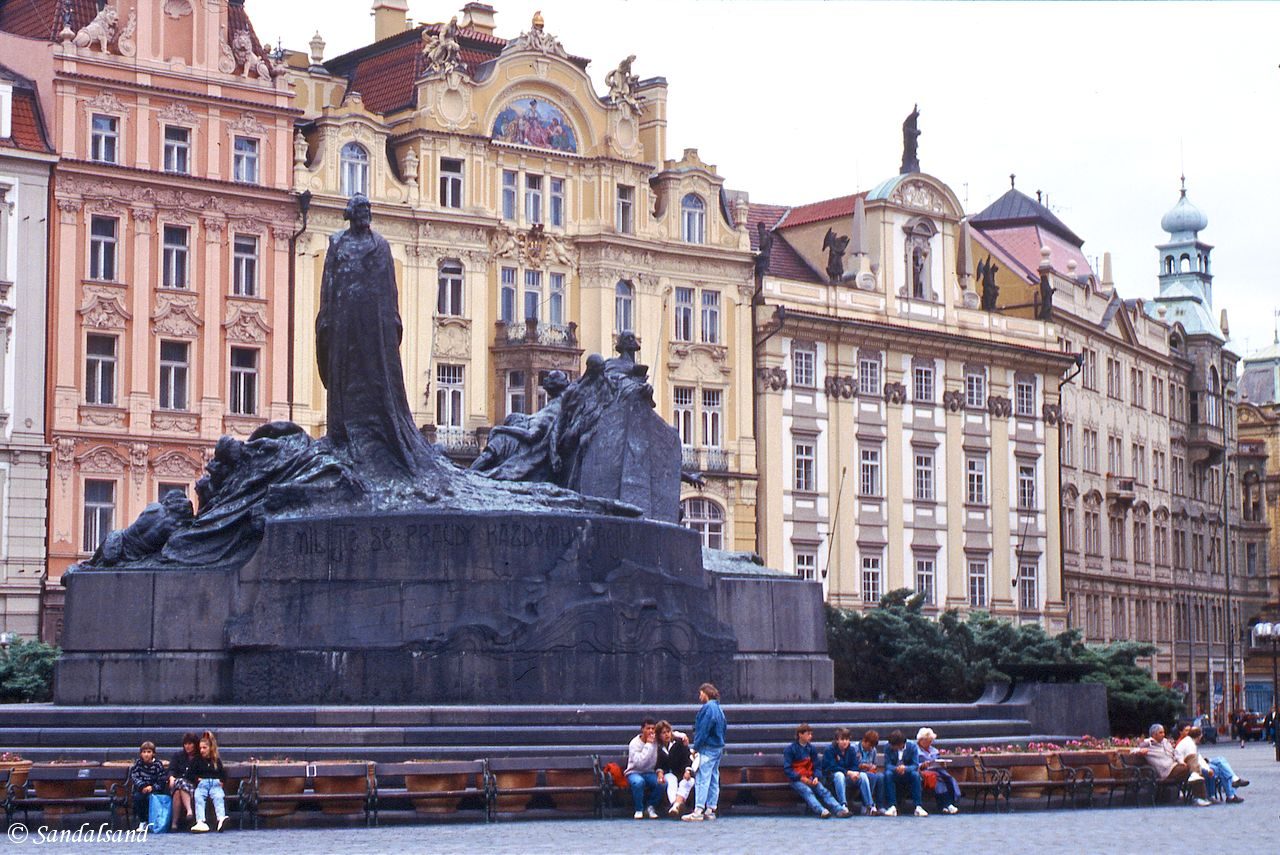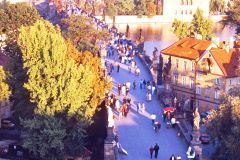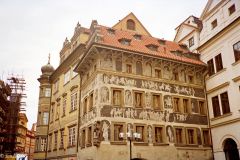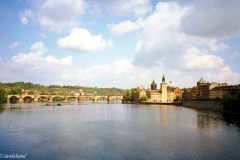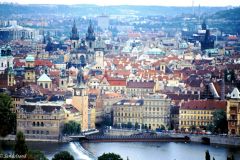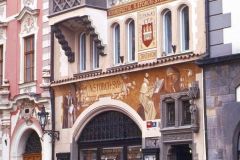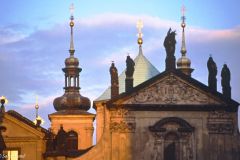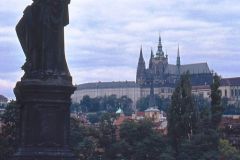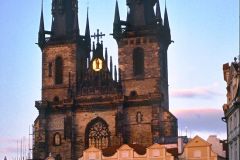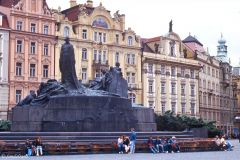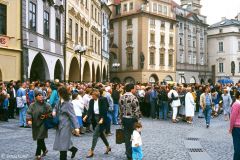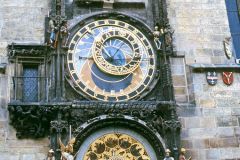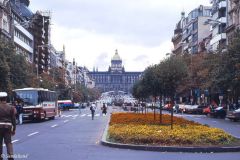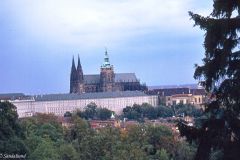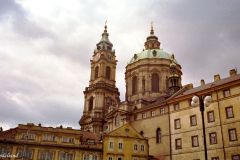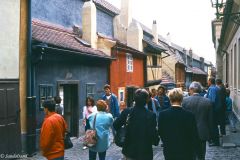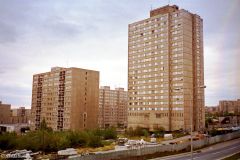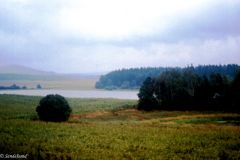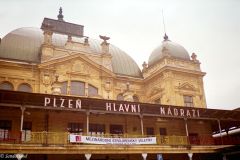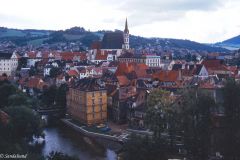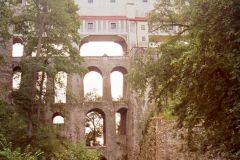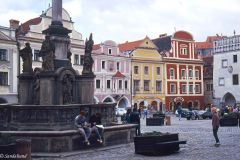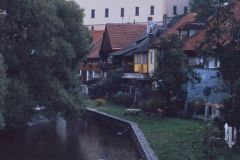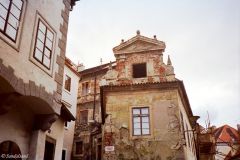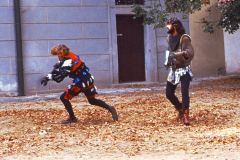Unlike East and West Germany, this chapter is about a country still united, later divided. We were going to the western part of former Czechoslovakia. It tells the story of a country rich in history, and may give some hints of an emerging future. I have split this description in two, this part is about the present-day Czech Republic, the next part about Slovakia.
This is article no. 2 in a series of 6. The 27 days long journey was on an InterRail train ticket a long time ago, in September 1990. We started in Norway and transited through Sweden. We then crossed the Baltic Sea to East Germany (DDR), and continued to West Germany (BRD), Czechoslovakia, Hungary, Austria and Belgium. What follows are transcripts from my travel diary at the time. I have changed or added very little.
Saturday 8.9.1990, Praha
First impressions
We are in Czechoslovakia and in an immensely beautiful city.
The train from Dresden arrived in Prague, or Praha as I prefer to call it, around five in the morning. On the way we did not catch much sleep, only dozed in the sizzling heat of the train cabin. The passport control was right after Dresden for both countries. It went very swift.

Entry and exit stamps from Czechoslovakia in my passport
On the railway station in Praha we had to wait an hour in line for the exchange office to open. The office signposted that they could also arrange accommodation. We exchanged 50 DM at a rate of 15 korunas per DM. (When we travelled 1 USD equalled 6 NOK, 1.6 DM and 24 korunas judging by the cited rate. The Koruna is not a convertible currency.) They only had “expensive” private accommodation, but the girl behind the counter suggested it was possible to find something on a student campus. We went to Kolejo in a good underground transport system. We searched amongst huge blocks of flats and got a double room at 110 korunas, around 25 NOK. Communal shower and toilet, but clean sheets. A boring room but we were happy about it.
After settling down a bit we went downtown in a funicular and ended almost right on the famous Karluv Most, the Charles Bridge across the Moldau (Moldava). Before that we god acquainted to the low prices. We had a very cheap breakfast while watching locals buying huge cream cakes for less than 200 korunas.
Second impressions
The core of the city is just fantastic: Very well preserved buildings and not only churches. Also “ordinary” houses had beautiful, painted facades. Fine ornaments also on those that were not as well maintained. The entire old city is preserved and the Czech have been better than the (East-)Germans in taking care of its heritage. This is reflected in the fact that the city is swarming with tourists wandering the narrow streets and alleys.
How the Iron curtain was about to change
Up Vaçlavske Namesti, the Champs-Élysées of Praha, there were a lot of black market money changers. The offers were around 18-19 per DM, Deutsche Mark. The changers seemed thoroughly dishonest so we did not involve ourselves. Instead we went to an official bureau, one of many, and changed 50 DM. While I was busy changing a woman contacted my girlfriend in rudimentary English. She wanted to change DM as she was going to the west over the weekend.
The woman seemed utterly desperate and honest while telling about her need for Western currency. The Czechs are allowed to buy 150 DM a year and she therefore needed what extra she could get. We had mercy on her, led her out in the bank lobby so that our illegal business would not be too obvious. 70 DM at a rate of 16 exchanged hands and I have probably never seen a happier face – she was shining so brilliantly that it was easy to have sentiments for her.
We ended up together in a café. This would be her first trip to the West. She had formerly been to a number of Eastern Bloc countries, including Cuba. But the West was apparently the big thing. We wished she would not get disappointed. At the same time it seemed to us that her regard of the West was too high, her money was too short for the length of stay she was planning, and her naivety to possible hazards in that respect all too obvious. Must she not get disappointed, we felt.
Sunday 9.9.1990, Praha
Czechoslovakia is really cheap. Last night we went out to eat in the city. My pint of beer cost me only 2 NOK, as did wine. And both tasted well. Dinner comes at 10-20 NOK. And this was a good restaurant.
The Sunday started with sightseeing on the old castle above Praha, the Hrad?any. It is great, but the buildings are prettier downtown.
We also found out that we wanted to take a closer look at the new suburbs of Praha, the ones from the socialist era. We took a guess and went on a metro train to the last stop (Háje). Unfortunately the underground does not allow particular views but we took buses on the return. Háje was apparently perfect for us, huge areas of big, new blocks of flats. Laundry on balconies, a large shopping centre and flat on flat. Grey and big. The suburbs of Oslo are truly paradise on Earth compared to this.
We went home and I lay down on bed and did not wake up until 9 in the evening, after four hours. I slept badly last night and I have in addition caught a cold. We went into town to get something to eat. We detected that the city was almost dead. At least we had a hard time finding a place to eat.
Monday 10.9.1990, Plzen – Praha
Plzen, the home town of the pilsner beer must be visited. The town is a 2-3 hour train-ride south-west of the capital. What a boring town! In addition the weather was grey and we had a hard time finding beer to drink. But in the end I found one, after a 700 year old recipe. Good, but not very good.
Then straight back to Praha. Weird, but at six o’clock all the shops closed and all of a sudden the streets were empty. We dropped a planned dinner feast, bought a bottle of white wine and drank it back home on the campus. It was good.
Tuesday 11.9.1990, Ceské Budejovice
How we got there
We had found a train departure at 0830 and went off early. But to no avail. The railway time tables are easy to read here, with arrival and departure times for every single little station. The problem is that we cannot read the footnotes. Concerning the train we had pointed out we were now told that it only went on Saturdays and Sundays. The next train was at 1020 so we had to walk around town a bit. We bought newspapers: the Austrian Kurier and the British Financial Times. It is fine to get some news again, and we needed to do something because our train took five hours as opposed to 2.5 for “our” express train.
Another disadvantage of not speaking Czech was that we sat hungry on the train while it waited a full hour midway, in Tábor. We couldn’t leave as we did not know when the train was to continue. And there were few if any in the carriage to ask. Before arrival we also had to leave the train and take a bus into Ceské Budejovice. We were tipped by an American who learnt about it by coincidence.
In any case, we arrived finally in the station and went to the nearest hotel. It was full, but the lady in the reception offered to call around for private accommodation. And suddenly she had booked one for 400 korunas and the renters were on their way in a car. Well, okay.
Private accommodation
When they arrived it turned out that the price was 500, but for that we would get our own room, shower, toilet, breakfast and lift in and out of town. The place was apparently in an alright bus distance to the centre. All this proved correct.
The people knew very little German, but were very nice. The house had recently been renovated, with a lot of tiles. Clean and fairly stylish in an ordinary villa neighbourhood. After placing our packs in our room we were asked downstairs for coffee, ending up staying there for the remainder of the evening. It was a family of two plus two, where only the daughter at 18 spoke some German. But we had a good time, so in the end we also had dinner with them. The planned trip into town was dropped.
The father was unemployed, the rest were working. But how they could afford a car (new Skoda) and a very well refurbished detached house, I don’t know. They had only started to rent out the room in August so they still seemed uncertain about the role. Charming. In the garden they grew vegetables and had a pig. The average wage around here is around 5000 korunas a year (ca. 333 DM). No wonder everything seem so cheap for us.
Wednesday 12.9.1990, Ceská Krumlov
We were driven down to the railway station, put our bags in a locker and found out that we had time for a look in the city centre of Ceské Budejovice before the train for Ceská Krumlov.
Ceské Budejovice, or just Budweis in English, has a long pedestrian street ending in a large square. The square has a large fountain-monument in the middle and old, fine buildings around it. The pedestrian street is rather new with many people and shops. Not the big thing, even though the tourist brochure names the city the Florence of Böhmen (Bohemia).
The train to Ceská Krumlov was very local. Yet again we had to move over to a bus part of the way before re-boarding a train. It was incomprehensible to us. Along the way we got to see fine scenery and pleasant small villages. ?eská Krumlov was larger, but not less pleasant. The town is almost medieval, with narrow cobbled stoned streets and nice, small and well-kept houses. In the middle of the town, on a hill, towers the castle. We joined a guided tour – interesting.
We took a bus back to Ceské Budejovice, faster and more comfortable. Buses can obviously be an advantage and even though we are travelling for free on trains the price of an hour’s bus journey is not discouraging (3 NOK).
Our onward journey
Ceská Krumlov was meant to be our insight into the small towns of Böhmen (Bohemia). We did in any case continue our journey, this evening, with a night train to Košice in easter Slovakia, near the border to the Soviet Union. We did however run into trouble in the station, when trying to get a ticket. The lady behind the counter made her best not to understand our pronunciation of Košice.
It was all too obvious and even when local bystanders intervened trying to help us, she was reluctant to assist us. We interpreted the affair as a combination of old Eastern Bloc red tape, general lack of service and a possibility to wage power against privileged Westerners.
In the end we were lucky to get on a through train and we even managed to get a couchette at 8 NOK each. The drawback of taking a night train is of course that we are unable to see so much. This means that the region of Mähren (Moravia, or Morava in Czech) went by without our noticing anything. Not that we slept so much, a group of youngsters was making a lot of noise, but it got dark early.
Our journey on a map
This is the map of our journey through parts of Europe, on this InterRail. It includes all published articles, both travelogues and the World heritage sites we visited. There are also markers indicating links to articles with pictures from a particular country (including pictures from other trips).
We travelled by train, however the lines on the map show what a road trip by car would have been. Unfortunately, it is not possible to draw train lines on Google Maps.
Read more
This is an article in a series of six from a journey through East Germany (DDR), West Germany (BRD), Czechoslovakia, Hungary, Austria and Belgium in 1990. The text is a transcript of my travel diary at the time and illustrated with my photographs.
(1) East Germany: This is my diary from a four week train journey to Eastern Europe. We started in Oslo and crossed the Baltic Sea from Sweden to East Germany, at the time it was still DDR. After this we continued to Czechoslovakia and Hungary before cutting straight west through Austria to Belgium, visiting friends there. The return brought us back home by way of Germany, Denmark and Sweden.
(2) Czechoslovakia (1): Unlike East and West Germany, this next chapter is about a country still united, later divided. It tells the story of a country rich in history, and may give some hints of an emerging future. I have split this description in two, this part is about the present-day Czech Republic, the next part about Slovakia.
NEXT CHAPTER: (3) Czechoslovakia (2): My journey through the now non-existing country of Czechoslovakia here continues with the eastern part of Slovakia.
(4) Hungary: Hungary is a very nice country, with beautiful scenery, good wine and transportation challenges.
(5) Austria: These last parts of this one month InterRail to Eastern Europe involves going west to Austria and Belgium and the long way home to Norway. I have split the story in two. First off is Austria.
(6) Belgium: Famous squares and statues in Brussels and the return to Norway.

